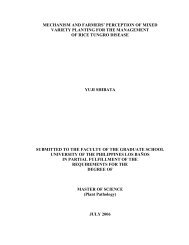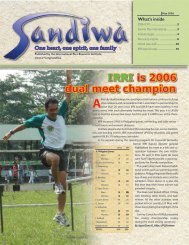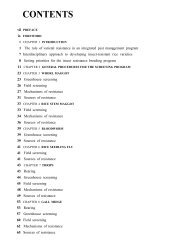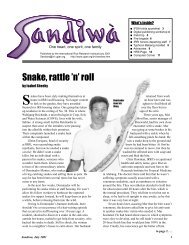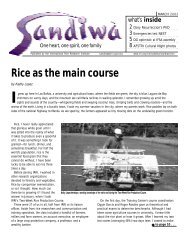Untitled - International Rice Research Institute
Untitled - International Rice Research Institute
Untitled - International Rice Research Institute
Create successful ePaper yourself
Turn your PDF publications into a flip-book with our unique Google optimized e-Paper software.
of the agar plate appears slightly zonated and<br />
black.<br />
Colonies on PSA at ART (28–30 °C) grow<br />
moderately fast and attain a 6.38-cm diam in 5 d.<br />
They are slightly zonated and densely floccose<br />
with sinuate margins, black, and later become light<br />
toward the margins. The colony on the reverse side<br />
of the agar plate appears slightly zonated and<br />
black. At 21 °C under alternating 12-h NUV light<br />
and 12-h darkness, colonies grow fast and attain a<br />
7.78-cm diam in 5 d. They are slightly zonated,<br />
densely floccose, black, and lighter toward the<br />
margins. The colony on the reverse side of the agar<br />
plate appears zonated and black. At 28 °C under<br />
alternating 12-h fluorescent light and 12-h darkness,<br />
colonies grow fast and attain a 7.56-cm diam<br />
in 5 d. They are slightly zonated, densely floccose,<br />
black, and become lighter outward with sinuate<br />
margins. The colony of the reverse side of the agar<br />
plate appears slightly zonated and black.<br />
Colonies on MEA at ART (28–30 °C) grow very<br />
fast and attain an 8.00-cm diam in 5 d. They are zonated,<br />
slightly floccose to felted, grayish to black, and<br />
become lighter outward. The colony on the reverse<br />
side of the agar plate appears zonated and black. At<br />
21 °C under alternating 12-h NUV light and 12-h<br />
darkness, colonies grow moderately fast and attain a<br />
6.53-cm diam in 5 d. They are zonated, slightly<br />
felted, and alternating white and light gray. The<br />
colony of the reverse side of the agar plate appears<br />
zonated, dark gray, and light toward the margins. At<br />
28 °C under alternating 12-h fluorescent light and 12-<br />
h darkness, colonies spread fast and attain a 9.00-cm<br />
diam in 5 d. They are zonated, felted, and alternating<br />
gray and light gray. The colony on the reverse side of<br />
the agar plate appears zonated and dark gray.<br />
Phoma sorghina (Sacc.) Boerema et al<br />
teleomorph: Mycosphaerella holci Tehon<br />
Disease caused: glume blight<br />
a. Symptoms<br />
Lesions are initially small, oblong, and brown,<br />
then gradually enlarge and coalesce, becoming<br />
whitish with small black dots.<br />
The fungus infects glumes during the second or<br />
third week following emergence of panicles.<br />
When infection occurs early, no grain is formed.<br />
On the other hand, when infection is late, grains<br />
are partially filled or become discolored and<br />
brittle.<br />
b. Occurrence/distribution<br />
This is a disease of the grain. It is widely distributed<br />
and the pathogen is often detected on rice<br />
seed from different regions and rice production<br />
ecosystems (Fig. 51).<br />
c. Disease history<br />
The disease was first reported in the U.S. and<br />
Japan and later reported in other rice-growing<br />
areas as well. The fungus P. sorghina has been<br />
reported under different names, including<br />
Phyllosticta glumarum (Ell. & Tracy) Miyake,<br />
Ph. oryzina Padw., and Ph. glumicola (Speg.)<br />
Hara, and Phoma oryzicola Hara with<br />
Trematosphaerella oryzae (Miyake) Padw. as its<br />
teleomorph.<br />
d. Importance in crop production<br />
The disease is a relatively minor problem of rice.<br />
Together with other diseases of the grain, the loss<br />
is



